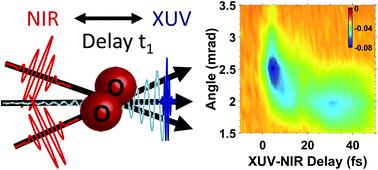当前位置:
X-MOL 学术
›
Faraday Discuss.
›
论文详情
Our official English website, www.x-mol.net, welcomes your
feedback! (Note: you will need to create a separate account there.)
Coupled nuclear–electronic decay dynamics of O2 inner valence excited states revealed by attosecond XUV wave-mixing spectroscopy
Faraday Discussions ( IF 3.3 ) Pub Date : 2020-12-18 , DOI: 10.1039/d0fd00113a Yen-Cheng Lin 1, 2, 3, 4, 5 , Ashley P. Fidler 1, 2, 3, 4, 5 , Arvinder Sandhu 4, 6, 7, 8 , Robert R. Lucchese 1, 2, 3, 4 , C. William McCurdy 1, 2, 3, 4, 5 , Stephen R. Leone 1, 2, 3, 4, 5 , Daniel M. Neumark 1, 2, 3, 4, 5
Faraday Discussions ( IF 3.3 ) Pub Date : 2020-12-18 , DOI: 10.1039/d0fd00113a Yen-Cheng Lin 1, 2, 3, 4, 5 , Ashley P. Fidler 1, 2, 3, 4, 5 , Arvinder Sandhu 4, 6, 7, 8 , Robert R. Lucchese 1, 2, 3, 4 , C. William McCurdy 1, 2, 3, 4, 5 , Stephen R. Leone 1, 2, 3, 4, 5 , Daniel M. Neumark 1, 2, 3, 4, 5
Affiliation

|
Multiple Rydberg series converging to the O2+ c 4Σ−u state, accessed by 20–25 eV extreme ultraviolet (XUV) light, serve as important model systems for the competition between nuclear dissociation and electronic autoionization. The dynamics of the lowest member of these series, the 3sσg state around 21 eV, has been challenging to study owing to its ultra-short lifetime (<10 fs). Here, we apply transient wave-mixing spectroscopy with an attosecond XUV pulse to investigate the decay dynamics of this electronic state. Lifetimes of 5.8 ± 0.5 fs and 4.5 ± 0.7 fs at 95% confidence intervals are obtained for v = 0 and v = 1 vibrational levels of the 3s Rydberg state, respectively. A theoretical treatment of predissociation and electronic autoionization finds that these lifetimes are dominated by electronic autoionization. The strong dependence of the electronic autoionization rate on the internuclear distance because of two ionic decay channels that cross the 3s Rydberg state results in the different lifetimes of the two vibrational levels. The calculated lifetimes are highly sensitive to the location of the 3s potential with respect to the decay channels; by slight adjustment of the location, values of 6.2 and 5.0 fs are obtained computationally for the v = 0 and v = 1 levels, respectively, in good agreement with experiment. Overall, an intriguing picture of the coupled nuclear–electronic dynamics is revealed by attosecond XUV wave-mixing spectroscopy, indicating that the decay dynamics are not a simple competition between isolated autoionization and predissociation processes.
中文翻译:

阿秒XUV波混谱揭示O2内价激发态的核电子衰减动力学耦合
多个里德伯系列会聚向O 2 + c ^ 4 Σ - ü状态下,通过20-25电子伏特极紫外(XUV)光访问,作为核解离和电子自电离之间的竞争的重要模型系统。这些系列的最低构件的动态,3sσ克约21电子伏特状态时,已经被挑战由于其超寿命短(<10 fs)的学习。在这里,我们将瞬态波混合光谱与阿秒XUV脉冲一起应用,以研究这种电子状态的衰减动力学。v = 0和v时,在95%置信区间下的寿命为5.8±0.5 fs和4.5±0.7 fs= 3s Rydberg态的振动水平分别为1。对预离解和电子自电离的理论处理发现,这些寿命主要由电子自电离控制。由于两个穿过3s Rydberg态的离子衰变通道,电子自电离率对核间距的强烈依赖性导致了两个振动能级的不同寿命。计算出的寿命对3s电位相对于衰减通道的位置非常敏感。通过稍微调整位置,对于v = 0和v,可通过计算获得6.2和5.0 fs的值= 1个水平,分别与实验良好吻合。总体而言,阿秒XUV波混谱揭示了耦合的核电子动力学动力学的有趣图片,表明衰变动力学不是孤立的自电离过程与预离解过程之间的简单竞争。
更新日期:2021-02-17
中文翻译:

阿秒XUV波混谱揭示O2内价激发态的核电子衰减动力学耦合
多个里德伯系列会聚向O 2 + c ^ 4 Σ - ü状态下,通过20-25电子伏特极紫外(XUV)光访问,作为核解离和电子自电离之间的竞争的重要模型系统。这些系列的最低构件的动态,3sσ克约21电子伏特状态时,已经被挑战由于其超寿命短(<10 fs)的学习。在这里,我们将瞬态波混合光谱与阿秒XUV脉冲一起应用,以研究这种电子状态的衰减动力学。v = 0和v时,在95%置信区间下的寿命为5.8±0.5 fs和4.5±0.7 fs= 3s Rydberg态的振动水平分别为1。对预离解和电子自电离的理论处理发现,这些寿命主要由电子自电离控制。由于两个穿过3s Rydberg态的离子衰变通道,电子自电离率对核间距的强烈依赖性导致了两个振动能级的不同寿命。计算出的寿命对3s电位相对于衰减通道的位置非常敏感。通过稍微调整位置,对于v = 0和v,可通过计算获得6.2和5.0 fs的值= 1个水平,分别与实验良好吻合。总体而言,阿秒XUV波混谱揭示了耦合的核电子动力学动力学的有趣图片,表明衰变动力学不是孤立的自电离过程与预离解过程之间的简单竞争。











































 京公网安备 11010802027423号
京公网安备 11010802027423号